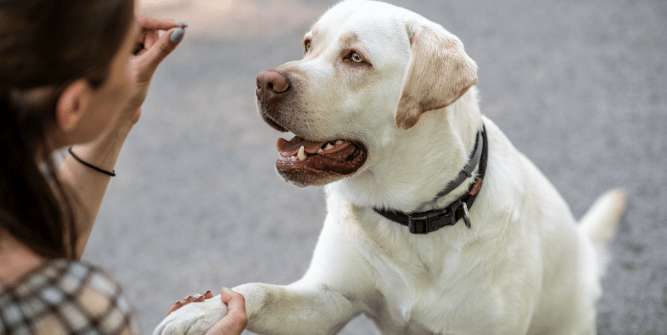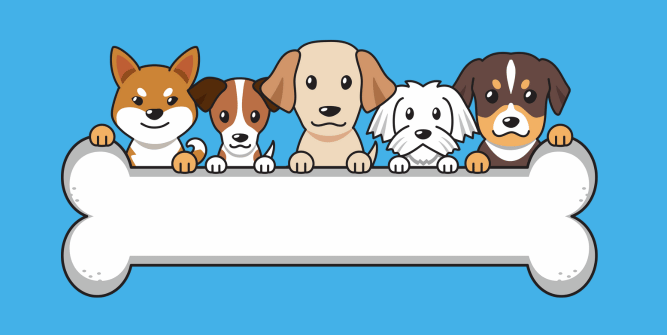
Mastering Manners: Essential Training Tips for Dog
Training a dog isn't just about teaching a few tricks; it's about promoting a healthy and happy relationship between you and your furry friend. Dogs are highly intelligent creatures capable of learning various tasks, tricks, and more. They are trained for very specific jobs that they can perform professionally. The foundation of successful communication and peaceful life with your dog friend is basic commands and manners. Let's look at how to establish a solid command structure that will guarantee your dog's compliance and good manners.
Essential Dog Training Tips
1. Start Early:
Start training as soon as you bring your dog home. Early training for dog sets the foundation for desirable behavior.
2. Consistency is Key:
Use consistent cues and commands. This helps your dog understand what's expected and reduces confusion.
3. Short Sessions:
Keep the exercises short, about 5-10 minutes. Dogs can focus better during short workouts because they have shorter attention spans.
4. Positive Reinforcement:
Reward your pup for good behaviour with treats, praise, or play. This will encourage your dog to repeat the actions you want.
5. Patience and Persistence:
Training takes time. Be patient and persevere, and celebrate small victories.
The Specialized Types of Training for Dogs

Positive Reinforcement
Positive reinforcement is all about rewarding good behaviour. When using this style of training for dog, you avoid punishing the dog for bad behaviours, instead, redirect them and only reward them for good behaviours with treats, praise, and toys.
Dominance Training
Dominance training is training that focuses on you being the alpha of the pack and your dog being subordinate to you. This type of training uses methods such as walking in front of the dog, going through the door first, and eating in front of the dog.
E-Collar Training
E-collar training utilizes an electric collar to correct unwanted behaviours. Depending on your preferences and the dog's response, the collar can shock, vibrate, or just create a noise. When the dog misbehaves, you may use the remote control to discipline it from a distance.
Clicker Training
Clicker training is essentially signalled positive reinforcement. A click indicates that the dog has done what you want, indicating that it is time for a reward. While this is great for teaching new behaviours and tricks, it’s not a great method for stopping behaviours you don’t want.
Obedience Dog Training
Every dog should go through obedience training, at least at the basic level. It should start early in life with the simplest sit and stand commands. This type of training for dogs is meant to prepare them for the many social situations they might encounter throughout their lives. You want to make sure you have control over your dog when it matters, which is why obedience training is so important.
Behavioral Dog Training
Behavioural training is focused on helping your dog unlearn bad behaviours that you don’t want to see. It is used to stop things like digging, excessive barking, biting, poor walking skills, accidents around the house and more. This is perfect for dogs that are currently having such behaviour problems as it can help them to start behaving properly, which will enable them and their family to live much happier.
Therapy Training
Therapy dogs are not service dogs. Rather, they’re meant to provide comfort for people in vulnerable positions, such as people who are extremely sick in hospitals or those who are dying in hospice. Although therapy dogs have no special rights or protections under the law, to become certified, they must pass the American Kennel Club's therapy dog test, which requires them to be exceptionally well-trained, calm, gentle and friendly to strangers.
Agility Training
Agility training is the training you do for your dog so that he can do agility courses. You transport the dog over, around and through various obstacles, providing great mental and physical stimulation.
Service Training
Service training is the type of training that dogs go through to legally perform service work. Some examples of service dogs are mobility assistance dogs, hearing dogs, guide dogs, PTSD dogs, diabetic dogs, and many others. A dog needs special training for one disease, and it takes several years to fully prepare.
Retrieving
If you are a certain type of game hunter, a retriever can be invaluable. When taking down a duck, rabbit, or similar game, the dog may chase it or swim out and retrieve it, depending on the circumstances. Retrieving takes a lot of very specific training for dog and certain breeds are best for this task, including Golden and Labrador Retrievers. The dog cannot bite or try to eat the animal. He has to be gentle with his mouth and when you are hunting waterfowl he often has to swim out to retrieve a downed bird.
The Benefits of Dog Training

Training your dog has numerous benefits. Spend at least ten minutes a day training your dog.
When you invest time and effort in training your dog, you create an interactive experience that strengthens the bond between you and your furry friend. Through training sessions, you engage with your dog in a meaningful and enjoyable way, enhancing the relationship you share.
Moreover, a well-trained dog understands and follows commands, making them pleasant to be around both at home and in public settings. By teaching your dog basic manner skills, you can decrease the chance of getting them into inappropriate behaviors that may lead to uncomfortable interactions with people or other animals.
Dogs are intelligent animals that thrive on mental challenges, and training provides the mental stimulation they need to keep their minds active and healthy.
Training for Dogs for Beginners: Basic commands

Teaching your pup basic commands is the foundation for successful training. By creating desired behaviours and encouraging obedience, these instructions help you and your furry friend establish a communication language. We will examine the four fundamental commands—sit, come, stay, and down—in this part.
The Sit Command
It is one of the fundamental commands that every dog should learn. By teaching your dog to sit on command, you can control their behaviour in various situations, such as meeting new people or waiting for their food. Use a firm but gentle tone and a treat as a reward to reinforce the behaviour.
The Come Command
The command is crucial for safety and recall. It teaches your dog to come to you when called, ensuring they stay close and avoid potentially dangerous situations. This command is important when walking in unfamiliar areas or off-leash. Begin by calling your dog's name and using the word "come" in a clear, commanding voice.
The Stay Command
It promotes self-control and helps your pup wait patiently. When you want your dog to stay in one spot, as when guests arrive or at meals, this is extremely helpful. Give your dog a command to sit first, and then tell them to stay there by using a hand signal or the word "stay." Reward your dog for good behaviour as you progressively extend the stay.
The Down Command
The down command teaches your dog to lie down and stay in a submissive position. This command not only promotes calm behaviour but also helps prevent jumping or running towards distractions. Training for dogs for beginners starts with commanding your dog to sit, then using a hand signal or the word “down” while gently guiding them into a lying position.
By teaching your dog these basic commands, you are setting them up for a lifetime of obedience and better interaction with you and others. Remember to be patient, and consistent, and use positive reinforcement during the training process. With time and practice, your furry companion will learn these commands and become a well-behaved family member.
How Long Does It Take to Toilet Train Your Dog

Puppies can usually be adopted between four and six months, but some puppies are not 100% potty trained until they are 8-12 months old.
Your puppy's age, learning experience training method, and consistency can affect how long it takes to toilet train. For example, an 8-week-old puppy is a sponge of knowledge, an older puppy usually takes more time to learn because it has to modify what it has already learned. Puppies from less-than-ideal homes will usually encounter difficulties.
In some cases, you’ll find your puppy may catch on early but then regress, or they may go toilet outside at home but go the toilet inside when you are in a different house or environment. This is all normal. Use Zoivane potty training spray, It is ideal for dogs of all breeds, this spray attracts your pet to potty/ urine in location of your choice. The solution is non-toxic, making it completely safe for you, your pet, and the environment. The spray has been created from a unique, homegrown formula and is environmentally responsible.
How to train a dog for toilet
- Accidents can happen, so exercise patience, keep them out frequently, and keep an eye out for warning signals. You may need to take more frequently than you do.
- Carefully monitor your puppy between scheduled potty times. Not all puppies learn to tell their owners to go to the bathroom by barking or scratching at the door.
- Some puppies will be eliminated early on in a walk. Others need to move and play a little first.
- Clean accidents with an enzymatic cleanser to minimise odours that might attract the puppy back to the same spot.
- Once your puppy is housebroken, you'll usually need to reinforce the training when your puppy visits other houses or places.
Effective dog training is an art that will make your puppy a well-behaved and happy companion. By following important training tips, implementing positive reinforcement techniques, and using the right tools, you will create a rewarding experience for you and your furry friend. Most new pet parents are not prepared for the many challenges that come with a new pet, whether it's a 30-day-old puppy or a 5-year-old rescue cat. This is where we at Zoivane Pets want to step in.
Presenting the "Pet Training Collection". Containing every product a pet parent could ever need, these products are handpicked specially to make your pet parenting experience an ease & joy.

















Leave a comment
This site is protected by hCaptcha and the hCaptcha Privacy Policy and Terms of Service apply.